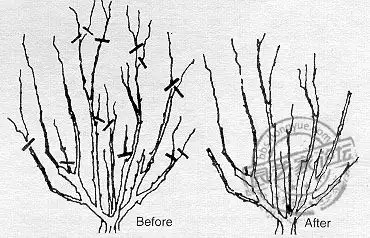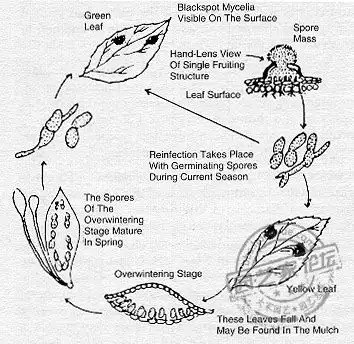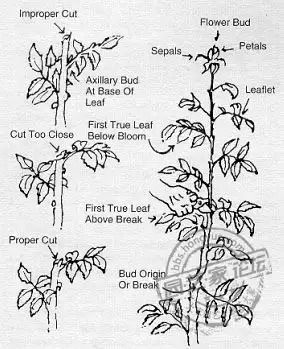Planting of roses
Planting of roses
The rose is the national flower of the United States and one of the most popular garden flowers there . There are over 6,000 varieties , encompassing a wide variety of types, colors, and fragrances. Blooming from spring to late autumn, roses can be planted individually or in large groups, creating a stunning visual experience. They can also be used as borders, along hedges, on trellises, and in flower beds. Every year, breeders introduce more varieties in new styles and colors.
With a little dedication and a little planning, you can thrive. Here are some key steps to help you get started right:
1. Choose a location that receives at least six hours of sunlight daily. 2. Prepare garden
soil rich in organic matter (preferably well-rotted animal manure, peat, or rotted leaves). A soil test a few weeks before planting will help you decide on fertilizer and lime additions. 3. Water regularly, providing an inch (2.5 cm) of rainwater weekly or every morning. 4. When removing flowers, be careful not to damage the plant. Use a sharp knife or pruning shears to avoid contaminating the wound. 5. Prune annually to maintain plant health and good shape. 6. Inspect plants regularly for pests and diseases so they can be detected and treated promptly. 7. Root mulch to maintain soil moisture and prevent weeds. Roses can be divided into two main categories based on their growth habits: shrub roses and climbing roses. Climbing roses have long branches and require support. Shrub roses, on the other hand, do not require support and can grow naturally , ranging in height from 30 to 180 cm. Shrub roses are mostly categorized by flowering habits, and generally include hybrid tea roses, multiflora roses, strong-flowering roses, little sister roses, hybrid periwinkle roses, shrubs, classic roses, tree roses, and miniature roses. Hybrid tea roses— The first hybrid tea rose was created in the mid-19th century by crossing the thin-stemmed tea rose with the large, profusely blooming periwinkle rose. Over the past 50 years, this hybrid tea rose has become a favorite for gardeners and florists. Thousands of varieties are cultivated today, with new ones being developed every year. Hybrid tea roses typically produce a single flower on a sturdy branch. Hybrid tea roses are often grown as cut flowers. While they vary greatly in size, shape, and color, they each possess their own charm, with hybrid tea roses blooming continuously. Multiflora roses— a hybrid of a hybrid tea rose and a small sister rose—are small roses with dense branches bearing small flowers, often in clusters. Multiflora roses are easier to care for than any other rose variety (except shrub roses) and bloom throughout the summer. Multiflora roses can be planted as borders or as accents in mixed plantings. Strong-flowered roses— also called large multiflora roses—have similar hardiness and flowering characteristics to hybrid tea roses. Large multiflora roses can grow into large bushes and produce more flowers, though the flowers are slightly smaller than those of hybrid tea roses. Multiflora roses— Flowers mostly bloom in clusters, with individual flowers smaller than those of multiflora roses. They are very similar to climbing roses and are well-suited for hedges or large plantings. They are easier to grow than hybrid tea roses. Hybrid Periwinkle roses— Flowers are profuse and spectacular, but lack the delicacy of hybrid tea roses. They bloom more frequently than older shrub roses and are sometimes better known as the "June rose" in your grandmother's yard. This variety was very popular before the advent of modern hybrid tea roses. With proper care, it can produce large, profusely blooming shrubs. It is cold-hardy and can withstand low winter temperatures without any protection. Shrub roses— Comprising a diverse group of hybrids and native varieties, some large, dense varieties are grown for landscape applications. They form large, dense clumps with smaller but eye-catching flowers, producing attractive seed clusters in the fall. Their small leaves make them useful for hedges and screens. Classical roses - These roses are commonly found in colonial gardens . There are many varieties and species. Although these varieties are more fragrant, they are not as beautiful as the newer varieties. These varieties are cold-hardy and require little care. They bloom profusely in June. Many old varieties are still around, but most are suitable for the climate of Alabama, tea-producing areas, France, Bangladesh,
. Some of these varieties are very suitable for the temperature and humidity of our country.
Tree roses - the characteristics of this type of rose depend on the shape of the plant rather than the shape of the flowers. This type of rose is grafted onto a straight stem from a shrub rose. Many varieties of this type of rose are derived from shrub roses. Tree roses can be grown for general use or treated specially, such as as a specimen.
Miniature roses - the plants are short, with small leaves and flowers. Some varieties can only reach 15 cm in height. They are generally used for ground cover edges, pot edges and decorative rock gardens.
Climbing roses - these varieties have long stems and need support to ensure that the plants do not grow on the ground. They can be planted on fences or trellises, while some varieties do not need support but need to creep on small hills to prevent plant rot. Due to their strong resistance, climbing roses have also become popular because of some good-looking varieties.
Climbing roses— Fast-growing and cold-tolerant, they can reach 600 cm in a season, making them better suited for hedges than other rose types. Their flowers are small, usually less than 5 cm in diameter, and they bloom densely, confined to branches from the previous year. Most of these roses have smooth branches and are susceptible to mildew, though larger, mildew-resistant varieties are being developed.
Large-flowered climbing roses— Compared to climbing roses, large-flowered climbing roses grow more slowly and are often supported by a trellis, pole, or other type of support. To maintain their shape, they require strong annual pruning. In suitable growing conditions, their flowers are large and readily survive cuttings . Most varieties bloom best when their branches are aligned.
Perennial climbing roses— They typically produce abundant flowers in early summer, then sparsely in autumn after the summer bloom period. Some varieties bloom continuously, similar to hybrid tea roses.
Hybrid scented climbing roses - This type of rose mostly comes from bud mutations of shrub roses. They are a branch of hybrid scented roses that has developed climbing properties, so new varieties are often named after shrub roses. For example: Climbing Crimson Glory. Generally speaking, hybrid scented climbing roses do not bloom continuously like their shrub parent, but their branches and flowers are generally very similar.
Ivy roses and multiflora climbing roses - This type of flower is a bud mutation of periwinkle roses and multiflora roses. They are generally similar to the parent shrub roses, and rarely bloom continuously.
Some recommended varieties
Hybrid Teas hybrid tea rose ma (medium red)
| Grandiflora rose n Elizabeth (pink) Floribunda 丰花月季 peana (dark red) Climbers climbing rose
|
The most suitable rose varieties for garden use
include: Multiflora, Hybrid Periwinkle, Little Sister, and Strong Flower. They are typically planted in patches, such as along shrubbery edges and at the base of hedges. They are rarely used as groundcover, as they are primarily cultivated for their flowers rather than their foliage. They typically remain bare in winter, though there are exceptions. Some varieties are still used today in patios or around garages.
Vines and climbing roses require support, such as poles, trellises, or walls. Some distinctive houses may use varieties with branches climbing up the house or lampposts. These varieties are well-suited for garden settings and use in hedges and walls.
Full sun is not suitable; morning sun is preferred over evening sun. Cutting beds for the ever-popular scented roses should be located away from areas with numerous tree roots and garden shrubs.
When purchasing and handling roses,
you should always source them from reliable sources. Local nurseries and florists are often a good choice. Reputable mail-order nurseries will send you a price list in advance, which often lists varieties favored by growers. You can select the varieties you like from this price list and then purchase them from your local nursery or florist. Choose high-quality plants; purchasing cheap, low-quality plants will not be worth the effort and expense. Rose grades are determined by the number of branches; the more branches, the higher the grade and the older the plant. Be careful not to buy roses with waxed branches; in the hot South, the wax can melt and burn the branches.
Every rose grower wants to maintain their roses to their peak flowering state. While basic growing techniques are simple, providing the right growing environment will reward you with beautiful
blooms year after year. Roses require care from the moment they are purchased. It is best to plant them when they are dormant. In Alabama, planting can occur from December to early spring. It is crucial to plant the plants immediately upon receipt.
How to plant bare-root roses
: As soon as you receive them, remove the packaging and soak them in a bucket of warm water. Pre-treat them for 24 hours before planting to ensure they absorb moisture. If cold weather is approaching, don't leave them outdoors overnight; the cold and strong winds can kill them. If you're planting them after a few days, place them in a cool, dark place, tilt them, and sprinkle sawdust around the base.
Spread roots over a mound of soil to assure proper drainage for plants. Apply water when filling soil around mound. Spread the roots of the plant in the soil and ensure adequate watering. |
Planting
requires extra care; even the best roses on the market can yield disappointing results if not properly cared for. Slightly acidic clay soil (pH 5.5-6.5) is optimal. It's best to conduct a soil test before planting; this test will determine the appropriate fertilizer to add .
Avoid poorly drained soil, as waterlogging can kill the plant's roots. Remove the clay layer with a spade or by tilling. Ensure at least 15 cm of soil beneath the plant's roots and at least 60 cm around them to provide good sunlight and air circulation. This helps prevent diseases caused by poor air circulation, reduced sunlight, and root crowding.
If you're only planting a few roses, dig the hole. The hole should be 30 cm deep and 45 cm wide. If you're planting a large number of roses, fill it with soil to a depth of 30 cm and dig holes in the fill when you plant.
Mix soil with organic matter (leaves, compost, pine bark, etc.) at a ratio of 2:1. Fertilize and lime according to a soil test. If a soil test hasn't been done, add 1.8 kg of 8-8-8 and 12-6-6 fertilizers, or a similar amount per 100 square meters.
Mound the fill in the hole into a small mound. Dig a hole on top of the mound and plant the plant. Once established, ensure the plant's germination point is just above ground level. If you're unsure of the ground level, place a pole into the hole to calibrate the ground level. Be sure not to bunch the roots or force them into the hole. Fill the soil around the roots, pat it down firmly with your hands, and water thoroughly. Before planting, remove the packaging from the
potted plant
, but ensure the root ball remains intact. Dig a hole twice the size of the root mass, at the same depth as planting bare-root plants. Cover the soil ball with soil and water immediately after planting, taking care not to allow waterlogging.
After planting, place a sturdy stake next to the plant and tie it to the stake to prevent wind from blowing and loosening the roots.
Mulching the roots
: Root mulching can prevent weeds, conserve moisture, and increase soil fertility. Some effective mulch materials include pine bark, coarse-grained peat, corn cobs, pine branches, and well-rotted straw compost. Apply a 7-10 cm thick layer of mulch immediately after planting, and add to it annually to maintain a 10 cm layer.
A layer of ground cloth can be placed underneath the mulch to prevent weeds. Black plastic bags are generally not recommended, as they make irrigation difficult.
Watering
roses requires ample water, and even in areas with ample rainfall, moderate watering is essential. Watering should be done in the morning, and avoid watering the leaves to prevent disease problems.
Water to a depth of 20-25 cm, preferably with a light stream at the root level. Clay soils generally require a 2.5 cm layer of water weekly. Avoid flooding, which wastes water, as most of it will be lost and never reach the root zone more than 10 cm. Before
fertilizing
, perform a soil test. Your local land laboratory should be able to perform this test for you and provide advice on adjusting the pH and avoiding deficiencies.
Soils are often deficient in nitrogen and potassium. Although fertilization should be based on a soil test, Alabama generally uses 0.9 kg of 12-6-6 and 15-0-15 fertilizer per 100 square meters, with the first application in March, the second in July, and then in April, May, June, and August. Most rose media require ammonium nitrate (a 34-0-0 fertilizer) at a rate of 0.25 kg per 100 square meters.
Pruning
needs to be based on the shape, characteristics, and flowering color of the plant. Prepare for pruning as soon as the temperature is threatened by 0 degrees, leaving 3-5 strong branches to promote flowering. The number of branches pruned also depends on the variety, but the first pruning should remove dead, damaged and weak branches.
  Download (31.8 KB) 2009-9-25 16:58 | For most rose buds, cuts should be made below the third true leaf. For occasional longer stems, stems may be cut above the first true leaf above the break. First year plants should be cut higher (at or near the first true leaf) to allow more leaves to remain on the plant and produce food. For most roses, pruning should be done below the third true leaf, occasionally above the first true leaf on long branches and stems. The first year, pruning should be done high (at or near the first true leaf), leaving plenty of foliage on the plant to facilitate flowering and fruiting. |
For hybrid tea roses, branches damaged by cold, disease, or insects should be removed first. Then, remove all rhizomes below the grafting site. Remaining branches should be cut back to 30-38 cm (12-18 in) above the ground, or any damaged branches 2.5 cm (12 in) below a bud. Be careful of any branches damaged by cold or disease. Cold damage will manifest as browning on the branches, which often occurs as brown spots or in the middle of the branch. Prune 0.6 cm (12 in) above the bud and make the cut at a 45-degree angle. For most varieties, it is desirable to have new branches sprout from the center of the plant; remove any branches that extend too far outward. If you want a variety with extended growth, leaving only the inner buds will allow the plant to grow straight. For flowering varieties, leave only three to four strong branches, and these should be carefully pruned. Before pruning, determine the plant's location
and control the growth of branches that do not need to bloom by removing new or weak buds. Keep only two or three full buds on each strong branch. Tree rose pruning is similar to hybrid tea roses, with the tops pruned to 15-20 cm. To avoid excessive top branching, remove weak branches to allow for the emergence of compact new branches.
Download (32.98 KB) 2009-9-25 16:58 | Floribundas and grandifloras should be opened up so as to allow more light in to the plant. | ||
|   Download (30.26 KB) 2009-9-25 16:58 | ||
  Download (26.73 KB) 2009-9-25 16:58 | After each flowering, prune climbing roses back as shown. Prune weak, diseased, or dead stems back anytime they are observed. Do not allow climbers to become overgrown, with thick, dense growth of branches. After the flowering period, climbing roses need to be pruned as shown in the picture. Pay more attention to observation and cut off any diseased and weak branches. Do not let the climbing roses grow too densely. | ||
produce numerous flowers. Cut back the branches 2.5 cm below the dark area, removing any diseased or dead branches. Leave 3-5 strong, robust branches. Then, remove any slow-growing or inward-growing branches. The remaining branches should be cut to 45-61 cm above the ground, depending on the plant's growth.
Climbing roses. These roses typically bloom in early spring and require pruning after flowering. New growth should be retained, as it will produce flowers next year. Old growth
should be removed immediately after flowering. Some climbing rose varieties bloom throughout the growing season. These varieties produce new growth from older branches, rather than from the base of the plant. It's best to leave 5 or 6 strong branches and remove any older branches above ground level. Sometimes the remaining branches will produce very dense branches. To control growth and flowering, these side branches should be bent outward.
Climbing hybrid tea roses should be pruned lightly, only removing weak, diseased, and dead branches.
Rose cuttings. Because cuttings determine the growth form of the plant, the following are some introductions to correct and incorrect cuttings.
Correct cuttings first depend on the right cutting equipment - clean scissors or pruning shears and a pair of gloves to protect your hands from being pricked. Then decide on a suitable place to take the cuttings. If large, single, decorative flowers are required, remove the buds when they are very small. The cuttings should be 12-25 cm long, depending on the plant.
Ensure the cuttings have five nodes. To promote flower bud growth after cutting, roses have three, five, and seven nodes on each branch. The best place to cut is at the fifth node, as a full bud below the cut will germinate, which will eventually develop into a good flower bud. The next best places are at the seventh node, and then the third node.
Some roses can be harmed by pruning. In spring, cutting a long branch for cuttings may slow growth, as this removes many leaves. Branches that grow during peak season can be safely cut.
Some roses may root, but it's best to buy two-year-old, germinated plants from a reputable nursery. Some new roses are difficult to root and propagate. Even if you do root a new cutting, the root system is weak. Many varieties are protected, and unauthorized propagation is illegal unless approved by the importer.
How to maintain long-lasting cut roses. All cut roses have a lifespan, but there are some simple steps you can take to prolong their lifespan and enjoy their beauty . When you go outdoors to cut your flowers, bring a bucket of warm water with you. Place the branches in the water immediately after cutting them. Once you've collected your favorite flowers, bring them indoors.
Prepare the vase by adding a small amount of flower fertilizer to the warm water. The old-fashioned method is to add an aspirin or a penny, but this doesn't work. Science has discovered that adding flower fertilizer (not plant fertilizer) can satisfy and help the flowers last for 7-10 days. Too much or too little is not good for them. Be mindful of the amount of fertilizer you add to the vase, and use warm water, not too hot or too cold.
Once you have your vase ready, you need to trim the stems. Cutting the branches in water can help the flowers last a few days longer. When cutting in water, soak the bottom 5 cm of the branch in water. Make sure the cut is sharp and remove 2.5 cm. You should even see air bubbles entering as you cut. Cutting in water can help extend the life of the flowers by several days. Don't submerge the entire branch in water; this will not help and may even increase the risk of disease.
Cut flowers, especially roses, may wither quickly, but they can also revive and last for a few days. When cutting branches in water, make diagonal cuts, ensuring the cut is about 2.5 cm long. Cutting the branches in water prevents air from entering and promotes water absorption.
Rose Pest and Disease Control:
Growing roses is a rewarding endeavor, but controlling pests and diseases is equally important. Insects, mites, and diseases can quickly deprive roses of their beauty. If pest and disease control measures are not in place, the number and quality of flowers will be affected. The following information provides information on common rose pest control. For more detailed control measures, please consult your local Department of Agriculture technician.
Rose pests include
aphids, which appear on leaves, stems, and buds in early spring. They may appear sporadically in summer but are more common in autumn. Small or deformed flowers are likely caused by aphids, as they suck the plant's sap, hindering its growth. If the roses are severely infested, you may notice honeydew secreted by the aphids. This honeydew makes the leaves sticky and shiny, fostering sooty mold. If aphids are discovered in early spring, they should be treated promptly. Regularly inspect the plants, and kill female aphids in autumn to prevent them from laying overwintering eggs.
Caterpillars— Bollworms, armyworms, rose moths, and other caterpillars feed on flowers, buds, and leaves. Frequent and scheduled spraying can easily lead to caterpillar infestations. Caterpillars should be treated promptly when larvae appear. Alternatively, direct capture is an alternative to pesticide control.
Beetles—These feed on rose buds, flowers, and leaves, attacking plants at different stages of their growth.
Mites— These insects infest the undersides of leaves. Infested leaves develop yellow spots, then turn brown, curl, and eventually fall. Web-like structures may also appear in severely infested areas. These pests are so small they can only be observed through a microscope or magnifying glass.
Some mites are green with two spots, while others are red. Their reproduction increases with rising temperatures, peaking in midsummer. Excessive use of carbaryl can harm the mite's natural enemies, making the infestation more severe. Regular weed control in and around rose gardens is helpful, and the pesticide should be sprayed on the leaves.
Thrips – Thrips are very small, pale yellow insects that attack rose petals. They
typically burrow into the petals, causing brown spots on the flowers. Flower buds infested with thrips will not bloom properly. If you place a piece of white paper under the flowers and shake them, or if you pull apart the petals, you may see very small insects. Be sure to remove any flowers that have insects.
Rose Diseases
in Alabama, due to its long growing season, high annual rainfall, abundant dew, and relatively mild winters, make roses susceptible to a variety of diseases. Fortunately, control measures are effective against most pests and diseases.
Below are six common diseases found in Alabama, along with brief descriptions and practical control measures.
Black Spot Disease— This disease is the most devastating to roses in Alabama. Symptoms: Circular black spots with jagged edges appear on the leaves, accompanied by yellow halos. Leaves turn yellow and drop prematurely. In severe cases and without treatment, this disease can recur, eventually weakening the plant. The fungus, Powdery Mildew, is primarily spread by splashing rain and water droplets. The spores germinate in water on the leaf surface for six hours or longer, and leaf spots appear within five to ten days. [The following appears unrelated and likely a separate topic:] Life Cycle of Black Spot Disease . Powdery Mildew— This fungal disease occurs in spring or fall in Alabama. During the midsummer months, when black spot is also in full force, powdery mildew is less common. Plenty of rainfall and temperatures above 80°F (140°F) are not conducive to powdery mildew development. However, the presence of numerous powdery mildew spores on young leaves, main stems, and buds is a precursor to powdery mildew. Observed signs include leaf curling and stunted bud growth. Powdery mildew spores are wind-borne and are the primary vector of powdery mildew. Spores germinate and infect plants when relative humidity is high. Unlike black spot, powdery mildew spores do not require much water to germinate. Control measures (black spot and powdery mildew) - The first step in controlling powdery mildew and black spot is to maintain a clean environment. Any infected leaves (whether fallen on the ground or left on the plant) should be properly removed. This practice should be continued throughout the growing season. Because fungal spores overwinter on infected leaves and branches, it is particularly important to remove infected leaves near the end of the growing season. Sometimes, at the onset of the spring growing season, it's necessary to carefully prune diseased branches. In addition, root cover should be removed or replaced. During the dormant period, a mixture of lime sulfur (1:15) can be sprayed on foliage showing signs of infection. For best results, spray after removing old mulch from plants and the ground before applying new mulch. Effective control of powdery mildew and black spot is through fungicide spraying during the long growing season. The key is regular spraying and targeted application. Fungicides can also form a protective film, but once the disease has established itself, they are less effective against susceptible tissue. Crown gall (Agrobacterium tumefaciens) – This disease can cause gradual decline in rose plants. The pathogen that causes this disease often infects young seedlings in the nursery, ready for planting. Once established, the bacteria can survive for several years, even when not on the host plant. These bacteria are most likely to infect plants through wounds incurred during planting, cultivation , or grafting, or through bites from insects or other saw-toothed animals. Crown gall is a spherical disease that grows on the surface of lignified plants and can reach a diameter of more than 15 cm. It can reduce plant growth and inhibit growth and flowering. Aboveground symptoms are similar to those caused by nematodes. Control measures: Effective control measures are currently available for crown gall. Diseased plants should be completely removed and destroyed. Infected areas should be fumigated or sun-dried before replanting. Root galls should be carefully removed during transplanting to avoid damaging the roots. It is best to soak the roots of susceptible plants in pesticide before planting. Stem rot and stem blight (gray mold) can be caused by one of several fungi. These fungi are particularly prone to infecting weak and injured plants. These fungi can cause a range of problems, including crown gall and reduced soil fertility. Branches may turn from brown to black, and sunken lesions may appear on the plant. Complete plant infestation by the fungus can lead to plant death. Prevention and Control Measures (Stem Rot, Branch Dieback): Similar to the measures for controlling black spot and powdery mildew, first maintain a clean environment. Fungicide sprays are effective not only against black spot but also against stem and branch diseases. Sprays should be applied regularly as the plants grow. Viruses - Several viruses can infect roses in Alabama. Most viruses only cause minor leaf discoloration and are relatively minor. Because most viruses are spread through grafting, infected plants should not be used for propagation methods such as grafting. Viruses can also be spread by insects (especially aphids). Growers should remove infected plants to prevent the disease from spreading to other healthy plants. Variety Resistance - Different rose varieties have varying degrees of resistance to black spot, powdery mildew, and other diseases. For simpler management, choose varieties that are resistant to multiple diseases. Keep in mind that many popular varieties are susceptible to multiple diseases and may require a strict control regimen. Nematodes— Several types of nematodes are root parasites of roses. Symptoms of nematode infestation vary depending on the plant type, age, nematode species, and severity of infestation. Generally, symptoms include weakened plant growth, premature leaf drop, yellowing leaves, stunted growth, and stem dieback (but the roots remain intact). Roots infested by root-knot nematodes develop visible nodules (generally no more than 0.6 cm in size). Other nematodes that may infect roses include lesion, spiral, and stunt nematodes. Roots infested by these nematodes typically curl, discolor, and rot without the presence of nodules. These symptoms can often be mistaken for soil fertility deficiency or poor soil conditions. Aboveground symptoms are similar to those of crown gall. When purchasing roses, check the roots for nematode infestation. Once nematode-infested plants are planted in the garden, any preventative measures are largely ineffective. Avoid moving nematode-infested soil to uninfested areas. For nematode control, contact your local insect quarantine office. For more information on rose nematodes and control measures, see ANR-689, "Nematode Diseases of Flowering and Woody Plants." Use insecticides only according to label instructions. Follow the directions, precautions, and restrictions listed. Do not use insecticides on plant species not listed on the label. The insecticides mentioned in this book are registered with the Environmental Protection Agency and the Alabama A&M Department. If a pesticide's status has been changed or withdrawn, it is no longer recommended. Before using an insecticide, contact your local insect quarantine office for the latest information. Trade names are used for clarification purposes only. Alabama Cooperative Extension does not recommend or endorse any product and does not specifically recommend similar products.


